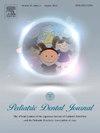Histopathological evaluation of pulpal health in traumatized discoloured primary incisors: A cross-sectional study
IF 0.8
Q4 DENTISTRY, ORAL SURGERY & MEDICINE
引用次数: 0
Abstract
Objective(s)
Tooth discoloration following trauma in primary dentition is a clinical indicator of potential pulpal pathology This study aims to assess the histological status of pulpal health in discolored traumatized primary incisors and its correlation with discoloration types.
Materials and Methods
A cross-sectional study was conducted on 55 pediatric outpatients (ages 3–7 years) between July 2021 and December 2022. Demographic details, time elapsed after trauma (TET), presence of symptoms, and discoloration type (Yellow, Grey, Pink, or Red) were documented. The extracted pulp tissue samples underwent histopathological assessment and were classified as: Normal/Healthy Pulp, Inflamed Pulp, Partial Necrosis, or Complete Necrosis. Statistical analyses were performed using the Chi-square test with a 95% significance threshold.
Results
Greyish discoloration was the most prevalent (87%), followed by pink (11%) and yellow (2%). Most cases (89%) were clinically asymptomatic, with 56.36% reported within six months of trauma. Histopathological examination revealed partial necrosis (42%), complete necrosis (38%), and inflammation (20%) in all discolored teeth. Despite these findings, no statistically significant correlation was established between discoloration type, histopathological pulp status, and TET (p>0.05).
Conclusion
(s): Greyish discoloration frequently coincides with pulpal necrosis. However, given study limitations, endodontic treatment should be guided by clinical and radiographic assessments rather than discoloration alone.
创伤性变色原切牙牙髓健康的组织病理学评估:一项横断面研究
目的:初生牙列外伤后牙体变色是潜在牙髓病理的临床指标。本研究旨在评估创伤后变色的初生切牙牙髓健康的组织学状况及其与变色类型的相关性。材料与方法对2021年7月至2022年12月期间55例3-7岁儿科门诊患者进行横断面研究。记录了人口统计学细节、创伤后时间(TET)、症状的存在和变色类型(黄色、灰色、粉红色或红色)。提取的牙髓组织样本进行组织病理学评估,并分为:正常/健康牙髓、炎症牙髓、部分坏死或完全坏死。统计学分析采用卡方检验,显著性阈值为95%。结果以灰白色居多(87%),其次为粉红色(11%)和黄色(2%)。大多数病例(89%)临床无症状,56.36%在创伤后6个月内报告。组织病理学检查显示变色牙部分坏死(42%)、完全坏死(38%)和炎症(20%)。尽管有这些发现,变色类型、组织病理学牙髓状态和TET之间没有统计学意义上的相关性(p>0.05)。结论:牙髓坏死常伴发灰白色。然而,考虑到研究的局限性,根管治疗应该根据临床和放射学评估来指导,而不仅仅是变色。
本文章由计算机程序翻译,如有差异,请以英文原文为准。
求助全文
约1分钟内获得全文
求助全文
来源期刊

Pediatric Dental Journal
DENTISTRY, ORAL SURGERY & MEDICINE-
CiteScore
1.40
自引率
0.00%
发文量
24
审稿时长
26 days
 求助内容:
求助内容: 应助结果提醒方式:
应助结果提醒方式:


